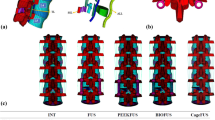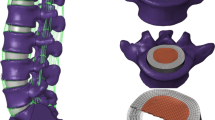Abstract
Purpose
To assess, with finite element analysis and an in vitro biomechanical study in cadaver, whether the implementation of an anterior interbody cage made of hedrocel with nitinol shape memory staples in compression increases the stiffness of the stand-alone interbody cage and to compare these constructs’ stiffness to other constructs common in clinical practice.
Methods
A biomechanical study with a finite element analysis and cadaveric testing assessed the stiffness of different fixation modes for the L4–L5 functional spinal unit: intact spine, destabilized spine with discectomy, posterior pedicle-screw fixation, anterior stand-alone interbody cage, anterior interbody cage with bilateral pedicle screws and anterior interbody cage with two shape memory staples in compression. These modalities of vertebral fixation were compared in four loading modes (flexion, extension, lateral bending, and axial rotation).
Results
The L4–L5 spinal unit with an anterior interbody cage and two staples was stiffer than the stand-alone cage. The construct stiffness was similar to that of a model of posterior pedicular stabilization. The stiffness was lower than that of the anterior cage plus bilateral pedicle-screw fixation.
Conclusion
The use of an anterior interbody implant with shape memory staples in compression may be an alternative to isolated posterior fixation and to anterior isolated implants, with increased stiffness.




Similar content being viewed by others
References
Cecchinato R, Berjano P, Damilano M, Lamartina C (2014) Spinal osteotomies to treat post-traumatic thoracolumbar deformity. Eur Spine J 24(Suppl 1):S31–S37
Berjano P, Lamartina C (2014) Classification of degenerative segment disease in adults with deformity of the lumbar or thoracolumbar spine. Eur Spine J 23:1815–1824
Berjano P, Lamartina C (2011) Minimally invasive lateral transpsoas approach with advanced neurophysiologic monitoring for lumbar interbody fusion. Eur Spine J 20:1584–1586
Berjano P, Langella F, Damilano M, Pejrona M, Buric J, Ismael M et al (2015) Fusion rate following extreme lateral lumbar interbody fusion. Eur Spine J 24(Suppl 3):369–371
Berjano P, Cecchinato R, Sinigaglia A, Damilano M, Ismael MF, Martini C et al (2015) Anterior column realignment from a lateral approach for the treatment of severe sagittal imbalance: a retrospective radiographic study. Eur Spine J 24(Suppl 3):433–438
Eysel P, Hopf C, Diop A, Lavaste F (1995) Multi-segment ventral stabilization of the lumbar spine: a comparative biomechanical study. Z Orthop Ihre Grenzgeb 133:242–248
Oxland TR, Lund T (2009) Biomechanics of stand-alone cages and cages in combination with posterior fixation: a literature review. Eur Spine J 9(Suppl 1):S95–S101
Cecchinato R, Berjano P, Bassani R, Lamartina C (2015) Osteotomies in proximal junctional kyphosis in the cervicothoracic area. Eur Spine J 24(Suppl 1):S31–S37
Gautschi OP, Garbossa D, Tessitore E, Langella F, Pecoraro MF, Marengo N et al (2015) Maximal access surgery for posterior lumbar inter body fusion (PLIF) with divergent, cortical bone trajectory (CBT) pedicle-screws: a good option for minimize spine access and maximize the field for nerve decompression. J Neurosurg Sci [Epub ahead of print]
Goins ML, Wimberley DW, Yuan PS, Fitzhenry LN, Vaccaro AR (2005) Nucleus pulposus replacement: an emerging technology. Spine J 5:317S–324S
Deb A, Majumder S, Roychowdhury A (2008) Biomechanical study of the lumbar spine with and without implant: a finite element approach. JJ Long Term Eff Med Implants 18:257–267
Zhang QH, Teo EC (2008) Finite element application in implant research for treatment of lumbar degenerative disc disease. Med Eng Phys 30:1246–1256
Buttermann GR, Kahmann RD, Lewis JL, Bradford DS (1991) An experimental method for measuring force on the spinal facet joint: description and application of the method. J Biomech Eng 113:375–386
Goel VK, Lim TH, Gwon J, Chen JY, Winterbottom JM, Park JB et al (1991) Effects of stiffness of an internal fixation device. A comprehensive biomechanical investigation. Spine 16:S155–S161
Janik TJ, Harrison DD, Cailliet R, Troyanovich SJ, Harrison DE (1998) Can the sagittal lumbar curvature be closely approximated by an ellipse? J Orthop Sci 16:766–770
Nissan M, Gilad I (1986) Dimensions of human lumbar vertebrae in the sagittal plane. J Biomech 19:753–758
Panjabi MM, Goel V, Oxland T, Takata K, Duranceau J, Krag M et al (1992) Human lumbar vertebrae. Quantitative three-dimensional anatomy. Spine 17:299–306
Xu R, Burgar A, Ebraheim NA, Yeasting RA (1999) The quantitative anatomy of the laminas of the spine. Spine 24:107–113
Lavaste F, Skalli W, Robin S, Roy-Camille R, Mazel C (1992) Three-dimensional geometrical and mechanical modelling of the lumbar spine. J Biomech 25:1153–1164
Totoribe K, Tajima N, Chosa E (1999) A biomechanical study of posterolateral lumbar fusion using a three-dimensional nonlinear finite element method. J Orthop Sci 4:115–126
Schleicher P, Gerlach R, Schar B, Cain CM, Achatz W, Pflugmacher R et al (2008) Biomechanical comparison of two different concepts for stand alone anterior lumbar interbody fusion. Eur Spine J 17:1757–1765
Cecchinato R, Berjano P, Aguirre MF, Lamartina C (2015) Asymmetrical pedicle subtraction osteotomy in the lumbar spine in combined coronal and sagittal imbalance. Eur Spine J 24(Suppl 1):S66–S71
Berjano P, Damilano M, Ismael M, Formica C, Garbosa D (2015) Minimally invasive PLIF with divergent, cortical trajectory pedicle screws. Eur Spine J 24(Suppl 5):S654–S655
Kok D, Donk RD, Wapstra FH, Veldhuizen AG (2012) The memory metal minimal access cage: a new concept in lumbar interbody fusion-a prospective, noncomparative study to evaluate the safety and performance. Adv Orthop 2012:898606
Kok D, Grevitt M, Wapstra F, Veldhuizen A (2012) The memory metal spinal system in a posterior lumbar interbody fusion (PLIF) procedure: a prospective, non-comparative study to evaluate the safety and performance. Open Orthop J 6:220–225
Betz RR, Kim J, D’Andrea LP, Mulcahey MJ, Balsara RK, Clements DH (2003) An innovative technique of vertebral body stapling for the treatment of patients with adolescent idiopathic scoliosis: a feasibility, safety, and utility study. Spine 28:S255–S265
Pejrona M, Berjano P, Cecchinato R, Casella A, Lamartina C (2014) Posterior surgery or lateral lumbar interbody fusion for degenerative deformity? Comparative data. J Neurosurg Sci 58:77–80
Kim HJ, Chun HJ, Kang KT, Moon SH, Kim HS, Park JO et al (2012) The biomechanical effect of pedicle screws’ insertion angle and position on the superior adjacent segment in 1 segment lumbar fusion. Spine 37:1637–1644
Kim TY, Kang KT, Yoon DH, Shin HC, Kim KN, Yi S et al (2012) Effects of lumbar arthrodesis on adjacent segments: differences between surgical techniques. Spine 37:1456–1462
Tang S, Rebholz BJ (2011) Does anterior lumbar interbody fusion promote adjacent degeneration in degenerative disc disease? A finite element study. J Orthop Sci 16:221–228
Yan JZ, Qiu GX, Wu ZH, Wang XS, Xing ZJ (2011) Finite element analysis in adjacent segment degeneration after lumbar fusion. Int J Med Robot Comput Assist Surg MRCAS 7:96–100
Tang S, Meng X (2011) Does disc space height of fused segment affect adjacent degeneration in ALIF? A finite element study. Turk Neurosurg 21:296–303
Formica M, Berjano P, Cavagnaro L, Zanirato A, Piazzolla A, Formica C (2014) Extreme lateral approach to the spine in degenerative and post traumatic lumbar diseases: selection process, results and complications. Eur Spine J 23(Suppl 6):S684–S692
Author information
Authors and Affiliations
Corresponding author
Ethics declarations
Conflict of interest
The authors of the paper have not received specific funding to perform the research. No conflict of interest has to be declared by any of the authors.
Rights and permissions
About this article
Cite this article
Berjano, P., Blanco, J.F., Rendon, D. et al. Finite element analysis and cadaveric cinematic analysis of fixation options for anteriorly implanted trabecular metal interbody cages. Eur Spine J 24 (Suppl 7), 918–923 (2015). https://doi.org/10.1007/s00586-015-4277-3
Received:
Revised:
Accepted:
Published:
Issue Date:
DOI: https://doi.org/10.1007/s00586-015-4277-3




